 Football matches are 90 minutes long, meaning that the balance of power can shift time and again throughout that hour and a half. Teams will often try to waste time in the hope that the referee will blow the whistle before the actual 90 minutes is over and done with. Theoretically, this sort of behaviour is stopped by the addition of added time at the end of each half, though the truth is that the amount of time that officials add rarely, if ever, reflects the actual stoppages and time-wasting that has occurred during the game.
Football matches are 90 minutes long, meaning that the balance of power can shift time and again throughout that hour and a half. Teams will often try to waste time in the hope that the referee will blow the whistle before the actual 90 minutes is over and done with. Theoretically, this sort of behaviour is stopped by the addition of added time at the end of each half, though the truth is that the amount of time that officials add rarely, if ever, reflects the actual stoppages and time-wasting that has occurred during the game.
During the Champions League final in 2005, Liverpool scored three goals in six minutes against AC Milan to prove that you only need a moment to change the course of a football match. Goals have been scored in a matter of seconds countless times across the years, which is why the match isn’t over until the referee has blown the full-time whistle. Indeed, in the age of the Video Assistant Referee, not even that statement is true, as Man United found out in 2020. We have a separate article on how many injury time goals are scored in the Premier League but the question is, how often is a football match won in injury time?
How Many Game Changing Goals Are Scored in Injury Time?
In the Premier League and English Football Leagues between the 2016-17 and 2020-21 seasons there were 729 games where the result changes due to injury time goals. This equates to 7.35% of all games played.
The highest percentage of injury time result changes occurred in League One (8.51%) followed by the Championship (7.36%), League Two (7.02%) with the Premier League the lowest with 6.21% of matches.
The Premier League
To start with, we’ll look at the Premier League and the number of times that the result of a match has changed during injury time in the second-half. Whilst goals can be scored during injury time in the first-half, there is still 45 minutes plus stoppages for the team that conceded to get back into the game. We have looked at the data across five seasons to get an idea of just how many times things can change, as well as the manner in which the result moves according to the team that scores the goal.
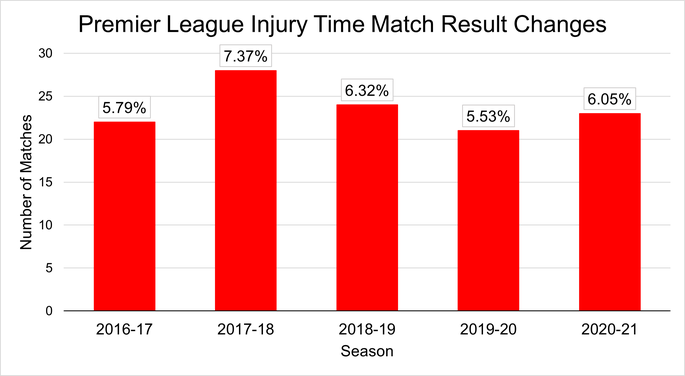
In total, 118 matches across the five seasons ended up with a different result at the end of second-half stoppage time than were in place at the beginning of it. That equates to 6.21% of all games, with the breakdown being as follows:
Premier League Injury Time Changes by Result
| Result Change | 2016-17 | 2017-18 | 2018-19 | 2019-20 | 2020-21 | Total |
|---|---|---|---|---|---|---|
| Home to Draw | 6 | 3 | 3 | 4 | 6 | 22 |
| Home to Away | 0 | 0 | 0 | 0 | 0 | 0 |
| Draw to Home | 7 | 10 | 8 | 8 | 4 | 37 |
| Draw to Away | 5 | 7 | 7 | 4 | 9 | 32 |
| Away to Draw | 3 | 8 | 6 | 5 | 4 | 26 |
| Away to Home | 1 | 0 | 0 | 0 | 0 | 1 |
The home team ended up getting at least a draw out of a match 64 times. That compares favourably to the 54 times that an away team managed to get at least a draw out of a game during injury time in the second-half.
There are some really interesting things to come out of the data from five years of Premier League football. For starters, it is interesting to note that only one match out of 1,900, or 0.05% of matches, saw the result completely swing from one team winning to another being victorious in second-half stoppage time. It is slightly less surprising that it was a home team managing to come from behind to beat an away side, but the fact that it is such a rare occurrence tells you plenty about the likelihood of it happening.
It is also interesting to see that there has only been one season out of the five that we’ve looked at in which the away team turned a draw into a win more often than the home team managed to do it. It is probably no coincidence that that was the only season in which there were no supporters in the grounds for long periods of the campaign, suggesting that the crowd does indeed make a massive difference to the outcome of a football match.
When Both Teams Scored In Stoppage Time
As you might imagine, stoppage time is usually a limited period of time in which not a huge amount happens. It is therefore somewhat surprising that you’d need two hands to be able to count the number of times that both teams have ended up scoring in the dying moments of the game. It happened eight times during the five seasons that we’ve been looking at, as you’ll see in more detail here:
Brighton 2 – 3 Manchester United (26/9/2020)
| Brighton | Manchester United |
|---|---|
| Neil Maupay 40′ (pen) | Lewis Dunk 43′ (og) |
| Solly March 90+5′ | Marcus Rashford 55′ |
| Bruno Fernandes 90+10′ (pen) |
Liverpool 4 – 2 Burnley (10/03/2019)
| Liverpool | Burnley |
|---|---|
| Roberto Firmino 19′ | Ashley Westwood 6′ |
| Sadio Mane 29′ | Johann Berg Gudmundsson 90+1′ |
| Roberto Firmino 67′ | |
| Sadio Mane 90+3′ |
Southampton 1 – 2 Cardiff City (09/02/2019)
| Southampton | Cardiff City |
|---|---|
| Jack Stephens 90+1′ | Sol Bamba 69′ |
| Kenneth Zohore 90+3′ |
Liverpool 4 – 3 Crystal Palace (19/01/2019)
| Liverpool | Crystal Palace |
|---|---|
| Mohamed Salah 46′ | Andros Townsend 34′ |
| Roberto Firmino 53′ | James Tomkins 65′ |
| Mohamed Salah 75′ | Max Meyer 90+5′ |
| Sadio Mane 90+3′ |
Liverpool 2 – 2 Tottenham Hotspur (04/02/2018)
| Liverpool | Tottenham Hotspur |
|---|---|
| Mohamed Salah 3′ | Victor Wanyama 80′ |
| Mohamed Salah 90+1′ | Harry Kane 90+5′ (pen) |
Everton 2 – 5 Arsenal (22/10/2017)
| Everton | Arsenal |
|---|---|
| Wayne Rooney 12′ | Nacho Monreal 40′ |
| Oumar Niasse 90+3′ | Mesut Ozil 53′ |
| Alexandre Lacazette 74′ | |
| Aaron Ramsey 90′ | |
| Alexis Sanchez 90+5′ |
Tottenham Hotspur 3 -2 Everton (05/03/2017)
| Tottenham Hotspur | Everton |
|---|---|
| Harry Kane 20′ | Romelu Lukaku 81′ |
| Harry Kane 56′ | Enner Valencia 90+3′ |
| Dele Alli 90+2′ |
Arsenal 2 – 1 Burnley (22/01/2017)
| Arsenal | Burnley |
|---|---|
| Shkodran Mustafi 59′ | Andre Gray 90+3′ (pen) |
| Alexis Sanchez 90+8′ (pen) |
Quite whether you can say that the result of the match changed in many of those instances depends on how you look at life. If a team was winning going into the match and still ended up winning, does that really mean that much changed? Equally, if a team was losing by three goals heading into second-half stoppage time and still ended up losing by three, does that make much of a difference? It will all be a matter of personal opinion, though in terms of the end result being actively different from the one at the start of stoppage time, it didn’t happen at all.
The most interesting match was the one involving Brighton & Hove Albion and Manchester United. The home side thought that they had earned a draw when the match referee blew the final whistle in the wake of their stoppage-time equaliser. However, the Video Assistant Referee, Simon Hooper, informed the match referee, Chris Kavanagh, that there had been a handball by Neil Maupay moments before he blew up. IFAB law 17.4 states, “If a penalty kick has to be taken or retaken, the half is extended until the penalty kick is completed.”
As a result, the match resumed and Bruno Fernandes converted the spot-kick for the Red Devils. Interestingly, the penalty would have been the last action of the game, so if Mat Ryan had saved it and someone had scored the rebound, the goal wouldn’t have been awarded. After years of ‘Fergie Time’ being a thing in the Premier League, rival supporters of Manchester United rolled their eyes and said ‘of course United can score a goal after the full-time whistle’, even though the decision was the correct one.
The Championship
Having looked at the Premier League and the number of times that injury time goals are scored in the English top-flight, it is worth having a look at the lower divisions to see if it is a common trait of football or not. We’ll start by looking at the same five seasons but this time across the Championship, the second-tier division in England:
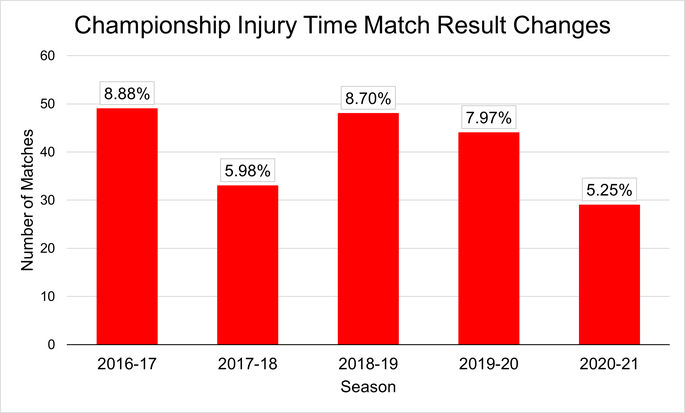
A quick glance at the above chart suggests that the level of defending in the Championship is poorer than in the Premier League. That is based on the idea that far more games have ended up changing hands in terms of control during second-half stoppage time than happened during the top-flight. In fact, 7.36% of all games saw a different result at the full-time whistle to the one we would have been expecting when injury time began being played. The breakdown is as follows:
Championship Injury Time Match Changes by Result
| Result Change | 2016-17 | 2017-18 | 2018-19 | 2019-20 | 2020-21 | Total |
|---|---|---|---|---|---|---|
| Home to Draw | 11 | 11 | 14 | 10 | 7 | 53 |
| Home to Away | 0 | 0 | 0 | 0 | 0 | 0 |
| Draw to Home | 16 | 3 | 10 | 15 | 9 | 53 |
| Draw to Away | 10 | 8 | 7 | 6 | 9 | 40 |
| Away to Draw | 11 | 11 | 15 | 12 | 4 | 53 |
| Away to Home | 1 | 0 | 2 | 1 | 0 | 4 |
Considering the fact that only one game in the Premier League ended up switching from an away win to a home win across five seasons, it’s certainly noteworthy that it happened four times in the Championship. It’s also interesting that the number of times it moved from a home win to a draw, a draw to a home win and an away win to a draw is identical at 53.
League One
Having established that it is more likely for the result of a match to change in the Championship than the Premier League, it is worth considering if the numbers keep going up when you drop even further down the Football League. Is it the case that defending gets worse, or attacking gets better, the lower down the footballing pyramid you look? For obvious reasons, we’ve stuck with the same five seasons of data:
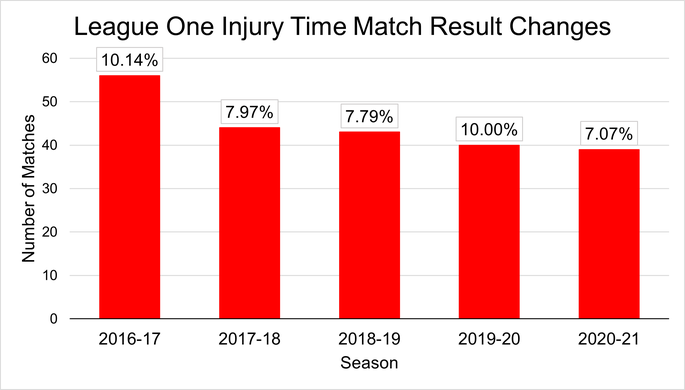
The first thing that is worth noting about League One is the fact that not all matches ended up being played in the 2019-2020 season. That is why it is useful to look at percentages rather than total games played. Without the percentage information, it would be easy to think that the 2019-2020 campaign was a freak one, but we can see that 2016-2017, in which all matches were played in front of crowds, actually boasts the highest percentage of games in which the result changed during injury time.
Another noteworthy thing about League One is that only one season didn’t feature a match in which the home team was able to overturn a deficit to the away side in order to win the match in the final moments of it. Across the 2386 matches that were played, 222 of them, or 8.51% saw a change of result during stoppage time in the second-half. The breakdown of changes was as follows:
League One Injury Time Match Changes by Result
| Result Change | 2016-17 | 2017-18 | 2018-19 | 2019-20 | 2020-21 | Total |
|---|---|---|---|---|---|---|
| Home to Draw | 12 | 12 | 10 | 9 | 13 | 56 |
| Home to Away | 0 | 0 | 0 | 0 | 0 | 0 |
| Draw to Home | 17 | 13 | 14 | 16 | 8 | 68 |
| Draw to Away | 17 | 9 | 10 | 7 | 8 | 51 |
| Away to Draw | 10 | 8 | 8 | 7 | 9 | 42 |
| Away to Home | 0 | 2 | 1 | 1 | 1 | 5 |
The fact that an even higher percentage of matches saw a change in result certainly backs up our idea that the lower the quality is of the football on show, the more likely it is that things can change quickly. Will that trend continue into League Two?
League Two
The bottom rung of the Football League would, you imagine, have a lower quality standard of football on show when compared to the leagues above it. The question is, does that necessarily mean that matches are more likely to change hands in the dying moments than in the so-called ‘better’ divisions?
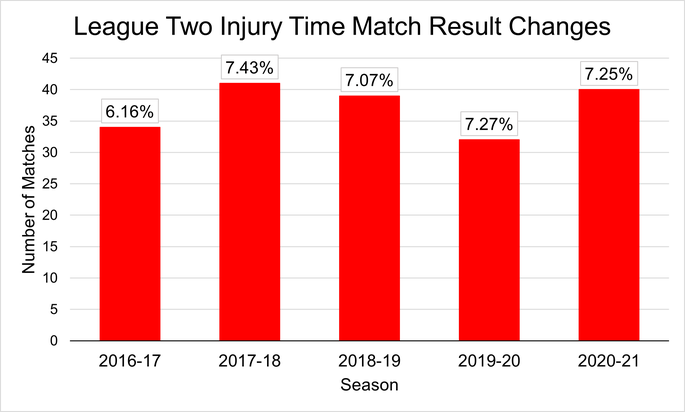
As with League One, not all matches were played during the 2019-2020 season, which was drawn to an early close. Even so, the first thing that jumps out is that the total number of games that saw the result change in second-half stoppage time has dropped to 7.02%, the closest to the Premier League’s total of 6.21%. If you were being unkind you might suggest that the very good and the very bad footballers are either able to stop games turning in the dying moments or unable to make it happen.
There were 2,462 matches played across the five seasons in question, of which 186 ended up seeing the result change in injury time at the end of the games. Here’s the breakdown:
League Two Injury Time Match Changes by Result
| Result Change | 2016-17 | 2017-18 | 2018-19 | 2019-20 | 2020-21 | Total |
|---|---|---|---|---|---|---|
| Home to Draw | 3 | 6 | 8 | 7 | 12 | 36 |
| Home to Away | 0 | 1 | 1 | 0 | 1 | 3 |
| Draw to Home | 12 | 14 | 11 | 9 | 10 | 56 |
| Draw to Away | 9 | 11 | 8 | 6 | 8 | 42 |
| Away to Draw | 10 | 8 | 10 | 10 | 8 | 46 |
| Away to Home | 0 | 1 | 1 | 0 | 1 | 3 |
The immediate thing that stands out is that there were three matches in which the home team was leading heading into second-half stoppage time, only for the away team to emerge with all three points. That is more times than in the other three leagues put together. Out of the 9,915 games that were played in the four divisions in England over the course of five seasons, just three resulted in such a turnaround. That is 0.03% of matches, so if the team you support is playing at home and is losing at the start of stoppage time, the chance of them winning the match is basically nil.
Manchester City’s 2011-2012 Season Finale
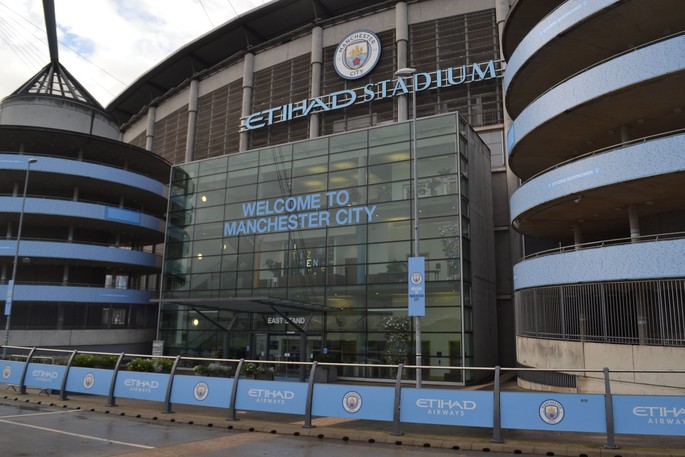
By Daniel, flickr
It is impossible to talk about goals scored in injury time that change the outcome of the football match and not mention what happened at the end of the season in 2011-2012. It had been a topsy-turvy battle between Alex Ferguson’s Manchester United and the ‘noisy neighbours’ of Manchester City, the latter of whom had yet to win a Premier League title after being taken over by Sheikh Mansour. Such was the nature of the season that the destination of the title hadn’t been decided heading in to the final game of the campaign.
Manchester United believed that they had won the title thanks to a 1-0 win over Sunderland, with the scoreline emerging from the Etihad saying that their neighbours were 2-1 to Queens Park Rangers as the match entered stoppage time. The game involving the Red Devils had been settled by a single Wayne Rooney goal on the 20 minute mark, but things were far more dramatic for the newly rich club in Manchester. City had taken a 1-0 lead through Pablo Zabaleta after 39 minutes, only for Djibril Cisse to equalise early in the second-half.
Alex Ferguson will have been forgiven for thinking that he had added another title to his trophy cabinet when Jamie Mackie put QPR ahead after 66 minutes, meaning that the Premier League trophy was heading to Old Trafford. This was in spite of the fact that Joey Barton had been sent off for the London club, but the extra man eventually told as City pressed forward for an equaliser of their own. That came thanks to Edin Dzeko, who scored two minutes in the added time at the end of the second-half to give City hope.
What came next has gone down in history as being one of the most dramatic moments in the English top-flight, with any football supporter old enough to remember it knowing exactly what an exclamation of ‘AGUEEERRROOOOO’ refers to. With five minutes having been added on to the end of the match, the time was all but up when the ball fell to Sergio Agüero in the Queens Park Rangers box. He smashed the ball past the QPR goalkeeper to hand Manchester City a 3-2 win and their first title for 44 years.
